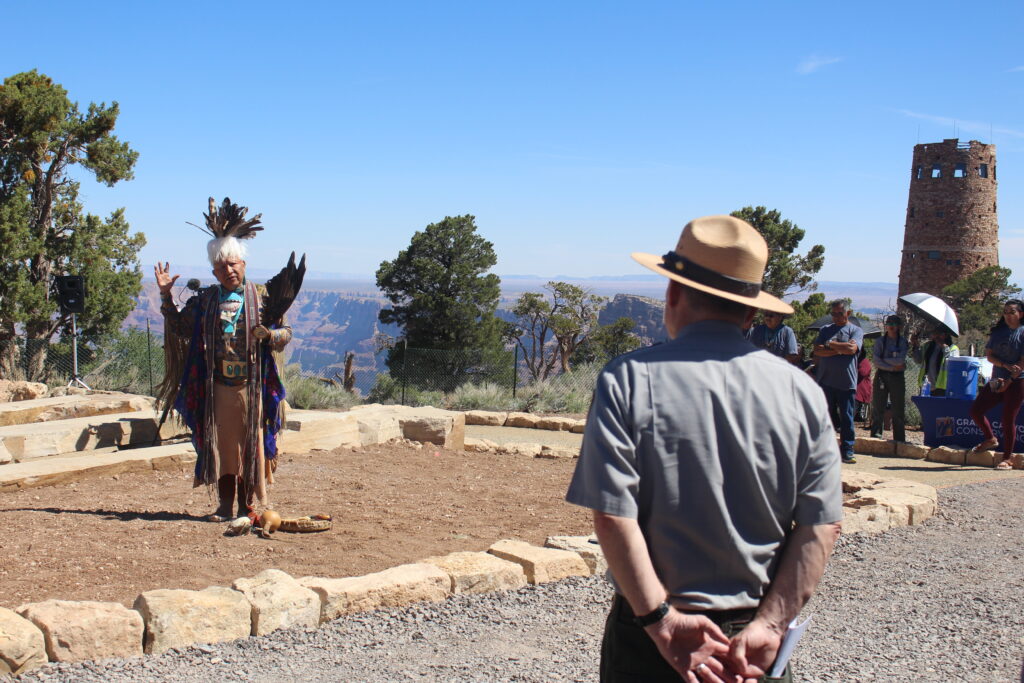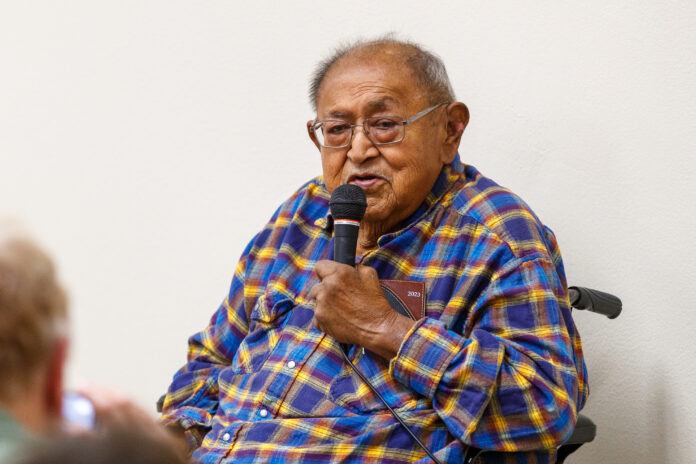“It’s not like the movie ‘[National Lampoon’s] Vacation,’ where the family goes across the country and they jump out of a car, take a quick look and jump back in the car off they go to the next spot and they get to the Grand Canyon and they look down inside and then they jump back in the car and they’re gone,” the late Vincent Randall can be heard saying every hour on the hour to the over 4.5 million annual visitors to Grand Canyon National Park.
Randall, a Dilzhe’e Apache and former Yavapai-Apache Nation Tribal Council chairman, who died Dec. 16 at the age of 83, lives on as the narrator of “We Are Grand Canyon,” the park’s new orientation film in which representatives of the 11 tribes traditionally associated with the canyon discuss their cultural connections to the site.
“Randall’s legacy to the community is multifaceted and complex,” YAN archaeologist Chris Coder said. “On the reservation he was a statesman/politician and cultural expert on Apache history … He was as well, if not better known, in the greater Verde Valley as a lifelong teacher in Clarkdale and a revered basketball and volleyball coach. I did a eulogy for his service at the old Clarkdale Men’s Club two days before this last Christmas and there were 400 to 450 people in attendance of every walk of life and culture.”
Randall began visiting the Grand Canyon in the 1940s, when he would accompany his father and uncles on week-long trips to collect piñon nuts and gather plant medicines with his mother and grandmother.
The Dilzhe’e Apache historically used the South Rim for resource procurement, particularly deer “and funneling antelope into brush corrals back from the Rim towards Red Mountain,” Coder said.
“The Yavapai-Apache Nation is the artificial amalgamation of the Yavapai [Yuman-speaking] people and the Athabaskan-speaking Dilzhe’e Apache, more commonly referred to as Tontos,” Coder stated. “This union was formed through the Indian Reorganization Act of 1934, which was a part of the New Deal legislation. The cultural connection to the Grand Canyon is mostly through the Apache side. However, if you consult Hualapai history, they say the Yavapai originated in the far west end of the [Grand Canyon] in Mata Widita Canyon, but left to the south before 1400 [CE].”
Ge Da Cho is among the names for the Grand Canyon used by Verde Valley Apaches, which Coder said roughly translates as “The Big Edge.”

“We Are Grand Canyon” was produced in partnership by the Intertribal Working Group, the Grand Canyon Conservancy and Grand Canyon National Park, and was filmed by Ryan Christensen of Bristlecone Pine Media.
Announced in a May 8 press release by the National Park Service, the film also features James Uqualla, a member of the Havasupai Tribe and a Sedona resident since 1990, who grew up in the remote village of Supai located below the rim of the Grand Canyon. The film is also one of the first visitor orientation films made by the National Park Service to adopt an American Indian perspective.
“I am not in the ability to be sitting down and talking with billions of people every hour physically,” Uqualla said. “So the way that this touches those people that I would not necessarily have the luxury of one-on-one, it becomes a great tool for them to better understand where they’re at, and what they must do to bring in their own awakening, a stronger sense of the better being. So for me, images are important to bring in the connection to a heart level of seeing and feeling and hearing the viewpoints of people within the region. And to see it in visual form, and from native people who are of the area, have much much to say.”
The film’s production was overseen by the Intertribal Working Group established in 2013, which is composed of representatives from each of the park’s associated tribes and consults with the park on its management and educational programing.
“The Intertribal Working Group had full input throughout the entire process all the way through to the final edit, which is another reason it took a while, because you have 11 tribes, and they’re very different people, they’re not monolithic,” GCC COO Mindy Riesenberg said. “They have different stories with Grand Canyon, origin stories or their connections to the canyon … We like to say ‘we moved at the speed of trust with our tribal partners’ … Grand Canyon National Park is a model for a lot of the other national parks in how we work with the tribes. And a lot of the parks have been coming to Grand Canyon National Park staff to learn about how to do this right with their tribal partners.”
In November 2022, the park renamed Indian Gardens along Bright Angel Trail to Havasupai Gardens following a request from the Havasupai Tribe that was approved by the U.S. Board of Geographic Names.
“Originally called Ha’a Gyoh, the NPS instituted policies that forced the Havasupai people from Ha’a Gyoh, and in 1928, the last Havasupai resident, [Thilwisa aka] Captain Burro, was forcibly removed,” the NPS stated in a press release. “Havasupai people continued to live and work within Grand Canyon National Park, despite the forced removal from the inner canyon.”
The park also rededicated the Desert View Watchtower on its eastern boundary in May 2022, when Uqualla opened the event with a traditional prayer and blessing, and this month marked the 10th anniversary of its Cultural Demonstration Program, which allows American Indian vendors to sell their wares at the park.
“What is beneath us, this Mother Earth — without her we would have no surface to walk, talk, breathe, sing or dance on,” Uqualla said would be his message if he could speak with people oneon- one. “Therefore every entity that is birthed onto the Mother Earth is required to maintain intimate, spiritual, heartfelt connection with the Mother Earth to care for it, protect it, nurture it, love it and be open to its messages as well as healing.”



